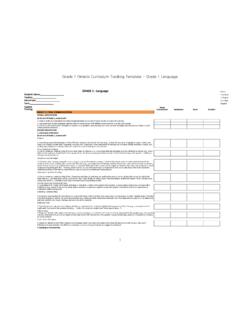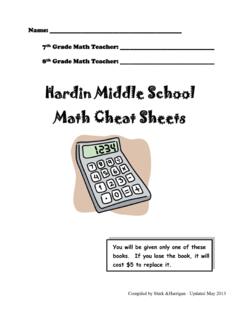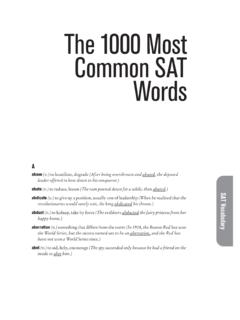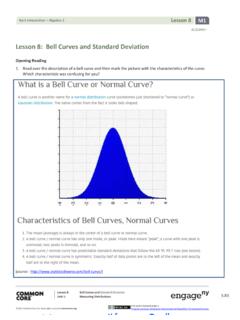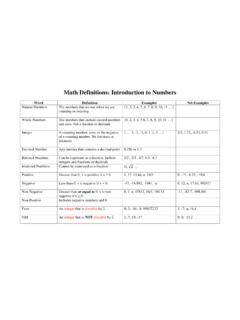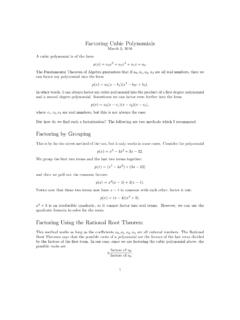Transcription of Math and Language Next Steps to use for Report Cards Math ...
1 math and Language Next Steps Student Evaluator Page 1 math and Language Next Steps to use for Report Cards LEGEND Next Step - # his/her $ Next Step - first name @ Next Step - he/she *Use the find/replace to change the codes below to the specifications of your Report card program. math Next Steps Next Step - regular drill and practice of number facts (give ) is necessary Next Step - $ should review the concepts of .. on a regular basis Next Step - $ should review the values of different coins Next Step - $ is encouraged to look back at # answer to see if it makes sense Next Step - $ is encouraged to practise making plans for solving problems Next Step - $ is encouraged to use arrays to display multiplication facts Next Step - $ is encouraged to use rounding to see if # answer is reasonable Next Step - $ is encouraged to use the 'Make Ten' strategy when adding Next Step - $ is encouraged to use the number line when (adding or subtracting)
2 Next Step - $ must read instructions carefully Next Step - $ must think carefully about what strategy to use to solve problems Next Step - $ must think very carefully and decide if # answers make sense Next Step - $ should practise making plans for solving problems Next Step - $ should use arrays to see the relationship between division and multiplication Next Step - $ is encouraged to answer "How do you know?" when explaining # answer Next Step - $ is encouraged to ask themselves, "Does this answer make sense?" Next Step - $ is encouraged to use the 'strategy wall' when explaining # thinking Next Step - $ is encouraged to answer the question "Tell us more?" when explaining # thinking. Next Step - $ should practise communicating # mathematical ideas and thoughts Next Step - $ is encouraged to cut fruit, sandwiches, etc.
3 In half, quarters and thirds Next Step - $ is encouraged to notice numbers in the real world and to make connections Next Step - $ is encouraged to practice counting money at home or when shopping Next Step - $ is encouraged to read prices and figure out to the closest dollar amount Next Step - $ is encouraged to use real coins to count out various money amounts Next Step - $ must have more opportunities to share objects equally (8 toys with 4 people) Next Step - $ must have more real experience with remainders (sharing 9 cookies with 4 people) Next Step - $ is encouraged to review the concepts of (give ) on a regular basis Next Step - $ is encouraged to time events to develop an understanding of the concept of time Next Step - $ should practise telling time using both digital and analogue clocks Next Step - $ should review the relationship between (give of units or time increments) Next Step - $ is encouraged to think, "Does this answer make sense?
4 " Next Step - $ is encouraged to use benchmarks when measuring (10cm = a popsicle stick) Next Step - $ should draw a shape on grid paper with a given perimeter Next Step - $ should draw a shape on grid paper and calculate their area math and Language Next Steps Student Evaluator Page 2 Next Step - $ is encouraged to practise estimating, measuring, and recording quantities Next Step - $ must discuss everyday measurements (25 L of gas, 5 km to school, 30 min. to bed) Next Step - $ must practise comparing, describing, and ordering objects by length Next Step - $ should read measurements of objects at home ( 1L of milk, 300 g of meat) Next Step - $ is encouraged to compare distances ( 5 km to school, 10 km to church) Next Step - $ is encouraged to make connections between measurement and the real world ( ) Next Step - $ must measure and compare time ( 50 sec.)
5 To tie shoes, 20 min. to cook rice) Next Step - $ must measure objects around the house (weight, length, capacity) Next Step - $ should order objects by weight or volume ( various food products) Next Step - $ should practise measuring the mass of real life items in (give ) Language Next Steps Next Step - $ is encouraged to reread text when meaning is unclear Next Step - $ must pay more attention to text features such as subtitles, captions and layout Next Step - $ must use # notes to distinguish between narrative and nonNext Step -fiction texts Next Step - $ should apply Language patterns to unfamiliar words by looking at the word wall Next Step - $ should review high frequency words by reading three word wall words each night Next Step - $ should use wall charts in the classroom to help with understanding Next Step - $ is encouraged to ask questions as @ reads to make sure @ understands Next Step - $ is encouraged to express # thoughts and feelings about what @ reads Next Step - $ is encouraged to slow down if @ does not understand what @'s read Next Step - $ is encouraged to talk about beginning, middle and end when retelling a story Next Step - $ is encouraged to use fixNext Step -up strategies when reading (give )
6 Next Step - $ must be more careful in choosing justNext Step -right books to read during independent reading Next Step - $ must make the pictures in # head (visualize) when @ reads Next Step - $ should ask questions when reading such as "What would happen " Next Step - $ should find the main idea by thinking about the author's purpose Next Step - $ should identify a purpose for reading (give ) Next Step - $ should identify strategies @ found helpful before, during, and after reading Next Step - $ should make connections to # own life when @ reads new material Next Step - $ should make predictions about stories after reading the title Next Step - $ should summarize material @ reads using the summarizing rules taught in class Next Step - $ should think about what the author is really saying when @'s reading Next Step - $ should think of personal connections to increase understanding when reading Next Step - $ should use a double entry journal to record # thinking while reading Next Step - $ should use reading comprehension strategies to improve understanding (give )
7 Next Step - $ is encouraged to express # opinions about what @'s read Next Step - $ must give evidence from the text when expressing opinions about what @ reads Next Step - $ must remember to give # own opinion when writing about what @ reads Next Step - $ should listen to stories on tape to improve fluency Next Step - $ should read orally to develop more expression and fluency (give ) math and Language Next Steps Student Evaluator Page 3 Next Step - $ should use # home reading book to read with expression and at an appropriate speed Next Step - $ should use prefixes, suffixes and root words to solve unfamiliar words Next Step - $ is encouraged to broaden # interests by reading different authors or genres Next Step - $ is encouraged to retell what @'s read to an adult to check for understanding Next Step - $ is encouraged to use the meaning of the passage to help solve unfamiliar words Next Step - $ must check more often to make sure @ understands what has been read Next Step - $ must make pictures in # mind as @ reads to improve # understanding Next Step - $ must pay attention to the punctuation when @ is reading Next Step - $ must read a variety of material ( novels.)
8 NonNext Step -fiction books, magazines) Next Step - $ must reread the sentence if @ does not understand Next Step - $ should confirm predictions by thinking "I thought , now I " Next Step - $ should continue to listen to an adult read to help make pictures in # mind Next Step - $ should continue to read to an adult to improve speed and smoothness of # reading Next Step - $ should make connections to the text when @ reads Next Step - $ should read a wider variety of texts (give ) Next Step - $ should read at # justNext Step -right level to improve # understanding of common words Next Step - $ should use prefixes/suffixes and word patterns to help read more difficult words Next Step - $ is encouraged to use class writing frames ( ) in order to produce short texts Next Step - $ must use (give ) to review letter sounds to help sound out words when writing Next Step - $ must use anchor charts in class to help understand the elements of good writing Next Step - $ is encouraged to use criteria ( ) to select and justify best pieces of writing Next Step - $ is encouraged to brainstorm and make lists in order to generate writing ideas Next Step - $ is encouraged to organize ideas using (give )
9 Before writing Next Step - $ is encouraged to proofread and use the editor's checklist to correct # writing Next Step - $ must reread # writing to see if @ has enough information to support # ideas Next Step - $ must spend more time brainstorming ideas in order to generate original topics Next Step - $ must use the story planner to help organize # thoughts before writing Next Step - $ should think of words @ could add to create a better picture for the reader Next Step - $ should use TNext Step -charts to understand different perspectives Next Step - $ should use a thesaurus, dictionary or other source to improve word choice Next Step - $ should use different sources to support ideas when writing a Report Next Step - $ is encouraged to confirm spelling and word meanings Next Step - $ is encouraged to maintain consistent verb tense in # writing Next Step - $ is encouraged to write more descriptive sentences by using joining words Next Step - $ must pay closer attention when using commas (give ) Next Step - $ must use more descriptive words in # writing in order to convey meaning Next Step - $ must use quotation marks correctly (give ) Next Step - $ must use the paragraph outline to write more complex paragraphs Next Step - $ should learn to spell unfamiliar words using strategies, such as.
10 Next Step - $ should use word wall and theme lists to confirm spelling of grade level words Next Step - $ should work on carefully choosing words that best suit the writing (give ) Next Step - $ is encouraged to show # 'voice' in all types of writing assignments math and Language Next Steps Student Evaluator Page 4 Next Step - $ must have a beginning, middle and end to all writing assignments Next Step - $ must include all parts when writing a friendly letter Next Step - $ must use the revising checklist to improve the final draft Next Step - $ should write about real life experiences in # journal Next Step - $ must listen actively and visualize to identify who is speaking in an oral text Next Step - $ should draw on personal experience to improve understanding when listening Next Step - $ is encouraged to organize # thoughts before speaking Next Step - $ must include a beginning.

